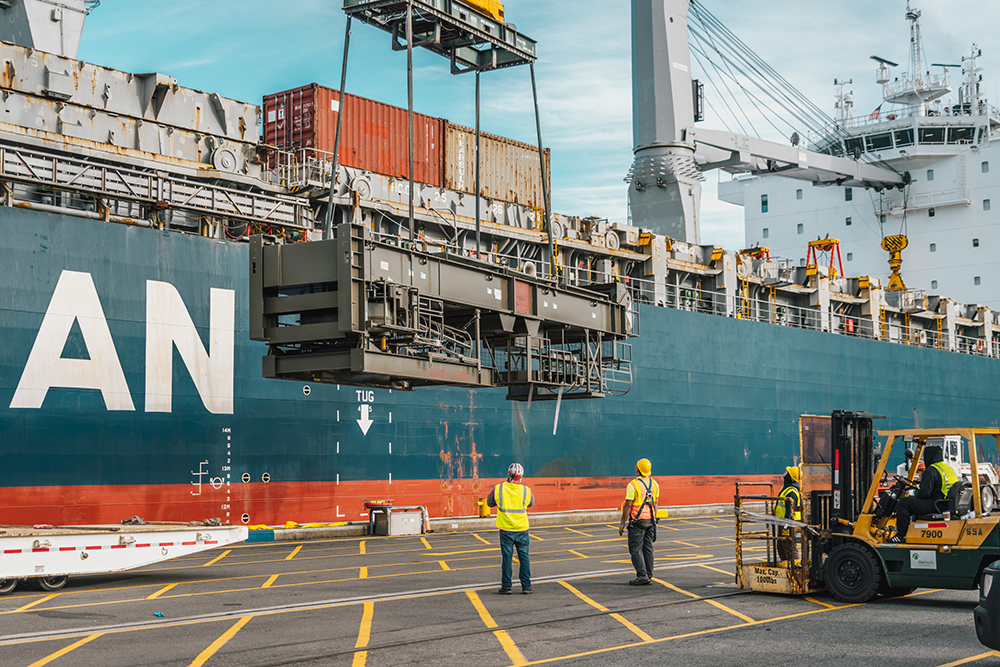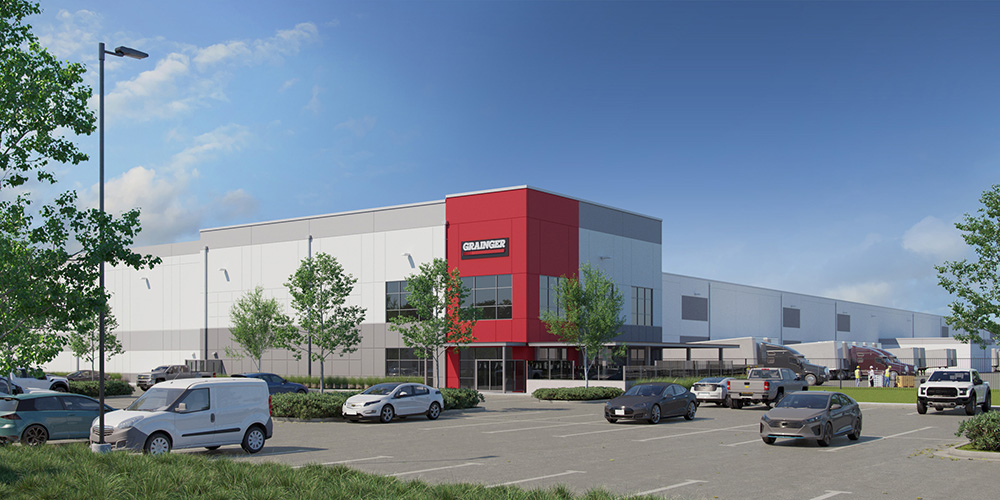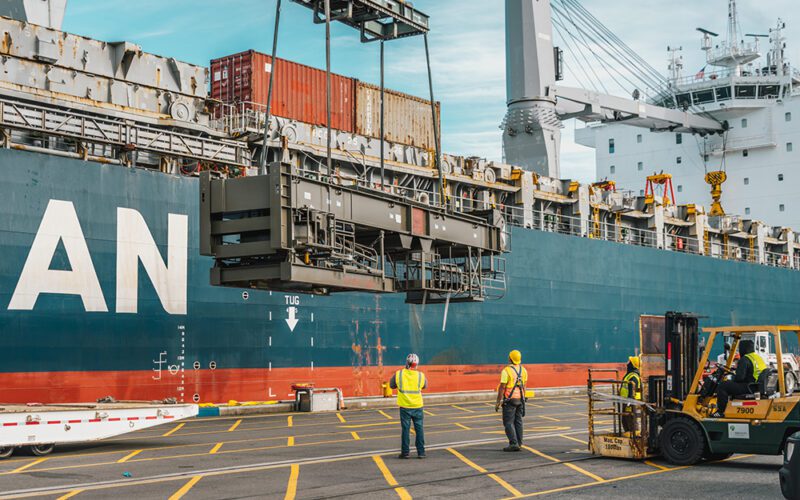
From multimillion-dollar infrastructure projects to facilities dedicated to the development of the region’s workforce, seaports in the Pacific Northwest are making investments to stay competitive.
Those investments in the Puget Sound are being supported by local, state and federal funding. The latest announcement came from the U.S. Department of Transportation’s Maritime Administration, which announced in early November that four projects in the region were among the recipients in the latest round of Port Infrastructure Development Program grants.
That includes $25.3 million for Port of Astoria’s Pier 2 West Rehabilitation Project, $7.7 million toward the Ko’Kwel Wharf Improvements Project in North Bend, Ore., $3.4 million in operational capacity improvements at the Port of Newport to help process and move breakbulk cargo and $54.2 million for the first phase of the Port of Tacoma’s Husky Terminal Expansion project.
Here’s a look at what’s been developing at seaports in the Pacific Northwest.
Seattle-Tacoma
The ports of Seattle and Tacoma say that innovation, efficiency and sustainability continue to be top priorities, and millions of dollars are being spent on projects that enhance port operations and the workforce.
The Port of Seattle is working on various projects, including building 120,000 square feet of possible industrial space at Terminal 91. The first phase of this project, estimated at $84 million, is currently in design and on pace for construction to begin in 2025. Pre-planning for the second phase is planned for next year, according to the port.
There has been significant investment in shore power and providing vessels plug-in capability at berths as part of a larger effort to decarbonize operations at the ports and achieve zero-emissions goals by 2050.
The Northwest Seaport Alliance, the marine cargo operating partnership between the Seattle and Tacoma ports, recently approved $9 million toward the final design for installing shore power at Terminal 18 in the Seattle Harbor. Engineering design for the project is expected to be complete this year, and construction is anticipated to begin in one-to-two years, according to the NWSA.
There are also plans to provide shore power to cruise ships arriving at Pier 66. The estimated $4-million project is expected to be complete in time for the 2024 cruise season.
Meanwhile, construction is expected to start in the new year on the $32.6 million Maritime Innovation Center at the port’s historic Ship Supply Building.
The building, which is anticipated to be complete in 2025, is expected to house non-profit maritime incubator Maritime Blue, which seeks to foster the exploration of new ideas and inventions for the maritime and fishing sectors.
“I think it could really be a beacon and a hub for innovation and draw our community together with that focus on the maritime industry’s future,” Dave McFadden, the managing director of the port’s Economic Development Division, told Pacific Maritime.
In Tacoma, the port has been working in partnership with Tacoma Public Schools to create the Port Maritime Center, a waterfront campus that would house a new port business office building for 150 employees and Tacoma Public Schools’ new Maritime 253 skills center. The goal is to give Pierce County high school students the chance to learn and develop skills geared to maritime and industrial trades.
The port and school district have chosen TCF Architecture/BNBuilders as the project’s design-build team and already have begun port building programming/design and site master planning work. They have said they expect 30% of the design to be completed by March.
Tacoma is also planning to work with the U.S. Army Corps of Engineers on the design of a project to dredge the Blair Waterway navigation channel to minus-57 feet.
The port and Seaport Alliance have also started the design phase on projects to deepen the international container terminals in the Blair.
For the deepening projects, the port hopes to use some of that clean dredging to develop the East Commencement Habitat Opportunity site for salmon and other wildlife. The project calls for about 20 acres of “nearshore restoration to create essential intertidal, shallow subtidal and riparian habitat that is currently lacking in Commencement Bay,” the port said.
Tacoma is also exploring possible uses for 50 acres of port property at the tip of the Blair Hylebos Peninsula, known as the Earley Business Center, home to several maritime services businesses.
The port is reviewing the market analysis of the site, which was previously used for shipbuilding, to determine its “highest and best use.” The goal is to develop a plan that guides the center’s overall reinvestment and redevelopment.
“We are focused on building a strong economic future for our region,” Port of Tacoma Commission President Deanna Keller said. “These investments will help us remain competitive … and grow tomorrow’s waterfront workforce.”
Port of Everett
The Port of Everett, which celebrated its 105th anniversary in 2023, hired Cara Craig as its trade development director in August. The former director of sales for Hillsboro, Ore.-based transportation firm Omega Morgan brings more than 25 years of experience in business development, global supply-chain management and transportation in North America.
She previously worked with the port on moving over-dimensional cargoes.
The port has been seeing business activity growing since last year’s opening of the new 40-acre Norton Terminal, the first all-new cargo terminal to open along the U.S. West Coast in more than a decade.
The $40-million project called for cleaning up and redeveloping the former Kimberly-Clark mill site, which had been sitting vacant for 10 years. Work included removing legacy contamination at the site and putting in a 9-inch-thick environmental pavement cap to allow for heavy cargo.
It also incorporated environmental controls and new, modern stormwater treatment for the first time in the property’s history, according to the port’s chief operating officer, Carl Wollebek.
Since opening in 2022, the terminal has moved more than 2,500 containers and more than 13,220 tons of breakbulk cargo. In October, the American Association of Port Authorities honored the project with an Overall Facilities Engineering Excellence Award.
“This nearly doubled the port’s upland cargo handling capacity, and now supports another 950 regional jobs while cleaning up the environment,” Wollebek said of the new terminal.
With Norton Terminal and its $57 million South Terminal modernization (which added another full-service berth in 2021) now finished and fully in use, the port is focused on investing in modernizing projects that green the supply chain.
The port is advancing efforts to bring electrification to its operations and recently finished a soliciting and selecting a consultant to help in the endeavor. The port already has secured a $5- million state grant and is preparing to apply for federal grants that could help officials further lower carbon emissions.
Plans to electrify the 650-foot Pier 3 are underway and would involve infrastructure upgrades for future potential electric harbor craft. When completed, it is expected to eliminate more than 630 tons of carbon dioxide annually, Wollebek said.
“This investment not only modernizes the port’s facilities but also aligns with future maritime innovations, positioning the Port of Everett as a leader in sustainable maritime operations,” he said.
The port is currently engineering the bio-retention treatment system, a project stemming from a recent lawsuit settlement with Puget Soundkeeper Alliance over heightened pollution discharge in the Puget Sound. The port plans to begin building the system in by fall of 2024.
The upgrade is expected to provide added treatment to the existing bioswale and better separate the runoff from the adjacent rail line, the port said.
Meanwhile, the pilot stormwater treatment system in the north yard of the port’s Hewitt Terminal has demonstrated great results, the port added.
The port is also investing an estimated $200 million to clean up South Terminal’s navigation and berth areas, significantly upgrade stormwater treatment facilities at South and Pacific Terminals and support the offshore wind industry emerging on the West Coast.
“We pride ourselves on quickly and efficiently handling high and heavy breakbulk cargo, including our niche in oversized aerospace components, as well as large pieces such as those in the emerging offshore wind space,” Wollebek said.
In addition, the port is looking beyond its boundary to develop economic opportunities for the region. In late October, the agency launched a survey to gauge community interest in having the port bring its tools and resources to more areas of Snohomish County.
The port is also focusing on maritime workforce development, engaging students at all levels to prepare for potential careers in the maritime industry. In late July, the port announced that the Maritime Institute signed a 10-year lease on a location at the Waterfront Place and plans to offer courses at its new mariner training facility starting in January.
This is the first location in Washington state for the San Diego-based company, which owns Pacific Maritime Magazine, Fishermen’s News and other trade publications.
The satellite facility plans to offer classroom and on-the-water training and certification opportunities for current and future mariners in the Pacific Northwest.
Port of Olympia
The Port of Olympia has been working on efforts to clean and restore Budd Inlet, which is filled with contaminated sediment from legacy industrial uses.
The port is waiting for environmental permit approvals from the state and federal government so officials can collect sediment samples from about 100 different locations, Shawn Gilbertson, director of Environmental Planning and Programs at the port, said.
Gilbertson said he expects sample collection to start in December or early 2024.
“And with all those samples, we’ll be able to get a kind of 3D model of what needs to be removed,” he said. “So, this is a huge endeavor.”
The data would be used to design a cleanup action plan, Gilbertson said. He anticipates construction beginning by late 2025 or early 2026, to be completed by 2030.
In other news, the port is expected to conduct a search for a new executive director in the coming months following its separation of service from former Executive Director Sam Gibboney, who had been in the top job since 2018. He was let go in September.
In the meantime, the port has named 19-year agency veteran Rudy Rudolph as interim executive director.
Port of Coos Bay
The Oregon International Port of Coos Bay has been pursuing grant funding with NorthPoint Development to help pay for the Pacific Coast Intermodal Port Project, a three-part endeavor to deepen and widen the Coos Bay Federal Navigation Channel, enhance the Coos Bay Rail Line and build a maritime terminal on a port property called the North Spit.
The state of Oregon has already committed $60 million toward the project.
Grant funding would pay for improving the rail line and channel. The port, which is working with the U.S. Army Corps of Engineers on the design and development of the channel project, plans to dredge the entrance to River Mile 8.2 from minus-37 feet to minus-45 feet and expand from 300 feet to 450 feet nominal width.
With the rail line, the port intends to modify its nine tunnels to accommodate double-stacked container traffic and add sidings to encourage train flow.
Meanwhile, NorthPoint would pay for construction of the terminal, which would facilitate more efficient and sustainable direct ship-to-rail and rail-to-ship flow. The terminal has the potential to handle about 1.2 million cargo containers a year and support about 2,500 direct jobs in Coos, Douglas and Lane Counties, the port said in August.
Moving containers by rail could curb emissions by as much as 75%, the port added.
In a Nov. 2 editorial published in Oregon Business, U.S. Sen. Ron Wyden argued that the project is worthy of federal funding, adding that “the port’s groundbreaking ocean-to-rail concept would take advantage of the significant geographic edge enjoyed by Oregon’s Bay Area to shorten transport times and compete with Canada.”

Port of Portland
The Oregon seaport has been focused on its efforts to strengthen operations at Terminal 6, including replacing electrical components to lower energy consumption and enable future zero-emission operations, adding a stormwater system to improve flows into the Columbia River and putting in a pair of emergency generators in the event of seismic events or other power outages.
Improvements also include expanding and strengthening nine acres of pavement for more container storage and enhancing 30 acres of pavement to the container yard.
In 2022, the port secured $7.3 million in Connect Oregon program funds and $24.3 million from the Maritime Administration’s Port Infrastructure Development Program, which went toward the estimated $42 million worth of improvements.
The port plans to continue making improvements to Terminal 6 into 2024. In January, the port is expected to start work on upgrading its cranes, including the installation of new electric HVAC units, the updating and replacement of direct current drives, programmable logic controller and crane management systems.
The port also plans to add new scales for inbound trucks beginning in December 2024.
“These operational improvements are especially important to agricultural producers in rural Oregon and throughout the Northwest who rely on us for reliable access to global markets,” said John Akre, a senior manager of marine marketing and business relations at the port.
“We look forward to increasing the efficiency, productivity and safety of cargo handling while also reducing our environmental impact at Terminal 6, the only marine container terminal in Oregon,” he added.
Akre also said that the port’s looking to attract a European carrier to further diversify its portfolio, as well as renew its efforts to boost interior port intermodal freight business.
Meanwhile, the new 530,000 square-foot distribution center at Gresham Vista Business Park (GVBP) is still on track for an early 2025 opening. Much of the groundwork on site has been completed and construction is on schedule, according to the port.
Portland announced in July that it had sold a development site at GVBP to GV5 LLC, a partnership formed by local firms Specht Development and Colas Development Group. GV5 LLC is developing for Red Agate LLC, a wholly owned subsidiary of W.W. Grainger Inc., a global maintenance, repair and operating product distributor.
The new distribution center is anticipated to create 80 jobs when it opens and could expand to more than 150 jobs in the future. The location also has room for possible future expansion of about 300,000 square feet.
KAREN ROBES MEEKS, a Southern California native, is an award-winning journalist with more than 20 years’ writing experience. Her articles have appeared in the Los Angeles Times, San Francisco Chronicle, Orange County Register and Long Beach Press-Telegram, where she worked as a reporter for nearly 14 years. Her work has been recognized by the California News Publishers Association, the Associated Press News Executives Council and the Los Angeles Press Club.

